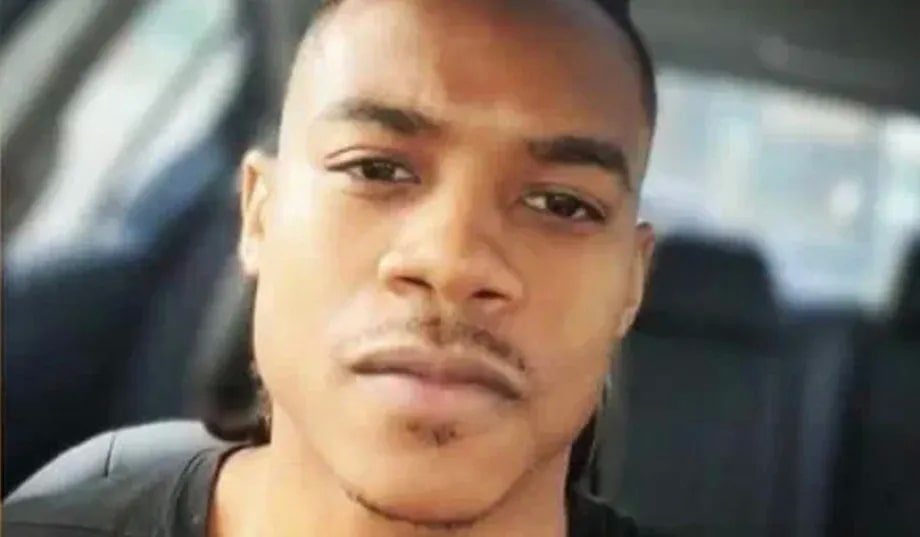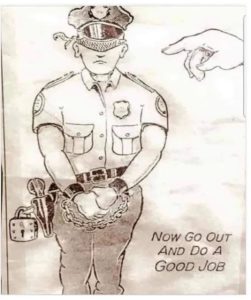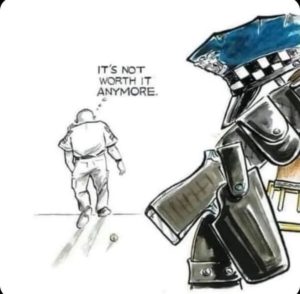The murder of an officer in the very center of our democracy is being treated as just some random thing that happened, all because the narrative didn’t fit.
NRPLUS MEMBER ARTICLESo a crazed white nationalist fanatic professing allegiance to a notorious hate group rammed a car into a security fence on Capitol Hill, killing a black police officer and injuring another after proclaiming on social media: “The U.S. Government is the #1 enemy of white people.” And what did the media do? They yawned. Reporting the basic facts of the case, along with a short profile or two of the killer, was the limit of its interest. No in-depth exploration of his “ties” or his “radicalization” or a broad inquiry into his hateful ideology was deemed necessary. No one explored the hate group’s links to celebrities, a current senator, and even a recent president.
The above scenario did not, of course, occur. And nor could it conceivably have occurred. A white-nationalist attack on the seat of our democracy getting memory-holed after a couple of days of perfunctory coverage? Not within the realm of possibility. If this had happened, it would have been one of the biggest stories of the year. There would have been hundreds of columns written about it. There would have been long panel discussions on CNN. There would be dozens of follow-up pieces and news analyses running on the front pages of the New York Times and the Washington Post. There would have been a National Conversation on this insidious issue.
Yet an attack like the one I’ve described did happen with the racial polarity reversed, and the media lost interest after a few days. Have you forgotten? On Good Friday, Noah Green, a 25-year-old donor to and aspiring member of the Nation of Islam, which the National Archive dubs a “Black nationalist movement” and which occupies “a prominent position in the ranks of organized hate” according to the Southern Poverty Law Center, killed a white police officer on Capitol Hill with his car and badly injured another officer, who was hospitalized. Green, who had written, “the U.S. Government is the #1 enemy of Black people” on Instagram and posted a link to a Nation of Islam speech entitled “The Divine Destruction of America,” then exited the vehicle with a knife and lunged toward other police officers, at which point he was shot dead.
This was no run-of-the-mill random attack, or at least that’s how it appeared at first. The assault “sent shockwaves through Washington DC,” CNN.com intoned. In an unusual joint statement, Nancy Pelosi and Chuck Schumer dubbed the slain officer, William “Billy” Evans, “a martyr for our democracy.” Mitch McConnell issued a similar statement. President and Jill Biden sent their condolences. White House and Capitol flags were lowered to half-staff.
So this was a major national story. Or was it? The New York Times published three pieces about Green and the attack on April 2 and 3, but has since gone silent on Green. In contrast, the Times has done seven stories in the same time frame focusing on the location of MLB’s All-Star Game.
That beats CNN.com, which has run stories on the slain police officer, the attack itself, and politicians’ reactions to it, but as far as I can tell hasn’t run a single story primarily about Green himself, except for a piece that ran on its scrolling Politics Live blog. Nor has CNN explored his possible motives in any depth. Apart from the blog post, the most detail I can find about Green on CNN’s website is three paragraphs within a 25-paragraph story about Capitol Hill tensions that ran hours after the assault.
NOW WATCH: ‘The Media Rebrand ‘Kids in Cages’’
The Media Rebrand ‘Kids in Cages’Volume 0%
As for our most prestigious journals of thought, neither The New Yorker nor The Atlantic has mentioned Green, as far as I can tell. Our least prestigious journals of thought have missed the story, too: I see nothing on Green at Vox.com.
The Washington Post published an account of Green’s upbringing and his final days within hours of the attack, but also has not mentioned him, except in passing, since April 5, under a story with the curiously elliptical headline, “Capitol Police officer was killed by car striking him, D.C. police say.” The officer was killed by . . . a car? That’s pretty big news. Should we all be more vigilant about killer cars roaming our streets? I’m having trouble applying this kind of writing to previous murders. “Charleston, S.C., worshippers killed by bullets, police say.” Doesn’t work.
All Our Opinion in Your Inbox
NR Daily is delivered right to you every afternoon. No charge.
The April 5 Washington Post story didn’t really tell us anything new about Green, except for giving us several paragraphs, and an accompanying video, that proved beyond a doubt that Green had indeed purchased a knife before wielding what appeared to be the same knife in his attack. There was a helpful interview with the owner of the cutlery store; yep, Green bought a knife there. The Post also informed us he was wearing blue jeans and a white sweatshirt when he bought the knife. Where and when he bought the car, and what he was wearing when he bought it, went unmentioned.
Nor did the Post or CNN get around to discussing the Nation of Islam in any detail, for instance by mentioning that it is one of the most deeply entrenched hate groups in America. (The Times briefly mentioned this, in the context of downplaying the idea.) Nor did the media make any attempt to link the murderer to all of the people who share his fondness for the Nation of Islam and its leader Louis Farrakhan, who call white people “potential humans . . . [who] haven’t evolved yet” and has made many nasty anti-Semitic and anti-gay remarks. “These false Jews promote the filth of Hollywood that is seeding the American people and the people of the world and bringing you down in moral strength,” he said in 2006. “It’s the wicked Jews, the false Jews, that are promoting lesbianism, homosexuality. It’s the wicked Jews, false Jews, that make it a crime for you to preach the word of God, then they call you homophobic!”
There have been no stories attempting to link Green to, say Senator Raphael Warnock, who praised the Nation of Islam as recently as 2013, or to Barack Obama, who in 2005 posed smiling for a picture with Farrakhan while joking, “He is much better looking than I am.” Farrakhan described Adolf Hitler as a “very great man” all the way back in 1984. If the Capitol Hill killer had shared with President Trump such a link to a Hitler-praising racist demagogue, do you think mention of this might have crept into the news coverage and op-ed pages once or twice?
The murder of an officer of the law in the very center of our democracy is being treated as just some random thing that happened, no more meaningful than an officer dying after being bitten by a rabid raccoon or felled by a lightning bolt. Yes, Green appears to have been a lunatic, yet how lunacy gets spread around by hate groups and conspiracy theories is an intense topic of discussion when it’s, say, QAnon-branded craziness. I doubt that if a QAnon-devoted white-nationalist murderer had clearly murdered a police officer on Capitol Hill, everyone would shrug and say, “Welp, it’s unfortunate that some people are crazy, but I guess there is nothing more to discuss.”
As for Green’s motive, in a hastily arranged news conference the day of the slaying, authorities both said they couldn’t pinpoint one but also sought to rule one out. “It does not appear to be terrorism-related,” acting D.C. police chief Robert J. Contee III said. So, no motive was known, but the most plausible one should be ruled out?
The media seemed to take this as a definitive statement valid for all time. But the assertion wouldn’t have passed the laugh test if a white nationalist member of an SPLC-certified hate group had carried out the attack after having proclaimed the government was the “#1 enemy of white people.” The Times published this howler: “Police have not categorized the incident as an act of domestic terrorism.” And yet “a senior law enforcement official” told the paper Green was motivated by both mental illness and “a connection to an ideological cause that provided justification to commit violence.” I’m having difficulty imagining this kind of doublespeak being applied to events that everyone knows were the work of terrorists. “The 9/11 hijacking was not terrorism, it was merely violence born of an ideological cause that provided justification.”
Perhaps there is some unknown motive for the assault. Maybe this particular Capitol Hill murder had nothing to do with politics. Maybe Green imagined he was a medieval warrior slaying mythical beasts and just happened to be on Capitol Hill when he suffered a psychotic break. Maybe he was suicidal and just happened upon the idea of using the police to effect his death.
But could it be that part of the reason we don’t know the motive for the murder is that . . . reporters aren’t looking for it? Since the assailant is dead, does the media consider the case closed? If the killer had been a white nationalist, hard proof of motive would not have been necessary. Every piece of commentary, analysis, and proposed solutions to the dire problem of white nationalism could easily have been written around the motive question. “After an avowed white nationalist and aspiring member of a racist hate group who called our government ‘the #1 enemy of white people’ murdered a black police officer with his car, fresh questions were raised about . . .” See what I did there? The known facts of the case are suggestive enough, regardless of whether the killer left a detailed manifesto.
If Green had had ties to a white-nationalist hate group instead of a black-nationalist hate group, the reaction of the media would not have been: Hey, let’s be sensitive and not hurt the feelings of anyone who belongs to this hate group. Let’s not assume any causation. Let’s not explore all the “links” and “ties.” Let’s . . . forget about this guy.






